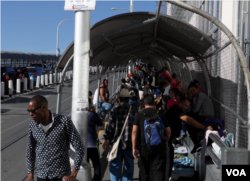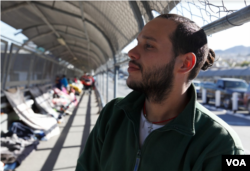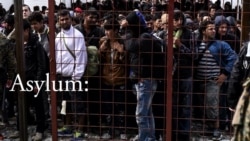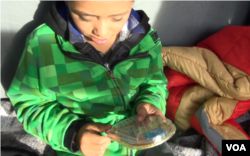Pay three pesos, or 25 cents, and pass through the turnstile. That is what it takes to get on the El Paso del Norte Bridge between Mexico and the U.S. Hundreds of migrants had been waiting here for a chance to request asylum.
"This process is very hard. It's been very cold. Then the sun is too strong. We don't have shade or a way to protect ourselves. But we are here. Life is hard, but we continue to move forward," Vilma Mendez Morales told VOA in Spanish last week.
Morales, 24, is one of about 200 people waiting on the bridge who are just part of the usual flow of migrants, hoping to get into the U.S. They did not belong to the much-anticipated caravan of migrants working their way north through Mexico that was targeted by President Donald Trump during the recent midterm election campaign.
Morales, traveling with her 1-year-old son, was waiting for almost a week on the bridge.
"We left Guatemala for a lot of reasons. We want to move forward. Fight for a better life and give my son a better life. … I hope God touches the president's [Trump's] heart to give us an opportunity," she said.
For shelter, the migrants had only makeshift tents of donated blankets, so on Tuesday, as temperatures fell to freezing, Mexican officials moved them to a local shelter.
The Mexican Red Cross, which has been assisting the migrants, gave each person a number so they could keep their place in line.
Caravan coming
Halfway across the bridge, two U.S. Customs and Border Patrol (CBP) field operation officers checked people's documents. Those hoping for asylum must wait due to space issues in the processing area, CBP officials said.
Eddy Gonzalez, who had been waiting on the bridge and observing, said "It's a good day" when they take 20 to 30 people into the processing center.
From Cuba, Gonzalez had been traveling for three years with a two-year layover in Ecuador to make some money.
Both he and Morales knew that Trump had signed an order suspending the granting of asylum to migrants who crossed the U.S. border with Mexico illegally.
The move came in advance of the migrant caravan from Central American countries. Several hundred of those migrants have already arrived at Tijuana, a Mexican border city. The United Nations estimates the rest, numbering in the thousands, will arrive in about a week.
In advance, the U.S. government is reported to be "hardening" the port of entry at Tijuana, and the number of U.S. troops stationed at the border may be increased from the current 7,900, U.S. Secretary of Defense Jim Mattis said Wednesday.
Rights groups have rushed to court to block the new asylum policy, which they say defies U.S. law.
"Under U.S. law, anyone arriving at port of entry or crossing in between a port of entry is eligible to apply for asylum if they have a fear to return to their home country," said Shaw Drake, an attorney for the American Civil Liberties Union's Border Rights Center in El Paso.
But U.S. Department of Justice Acting Attorney General Matthew Whitaker said in a statement that migrants who "contravene a presidential suspension or limitation on entry into the United States through the southern border with Mexico issued under section 212(f) or 215(a)(1) of the Immigration and Nationality Act (INA) will be rendered ineligible for asylum."
In a joint statement with Department of Homeland Security (DHS) Secretary Kirstjen Nielsen, Whitaker said the president's proclamation is "consistent with our immigration laws, the president has the broad authority to suspend or restrict the entry of aliens into the United States if he determines it to be in the national interest to do so."
DHS also released a "Myth vs. Fact" press release with questions and answers about asylum law and the president's proclamation.
There are two kinds of asylum: affirmative and defensive. An immigrant may claim affirmative asylum within one year of their last arrival in the United States. An immigrant may request defensive asylum while fighting an order of deportation.
Current policy is to detain asylum-seekers, often when they arrive at a port of entry or if they are detained between entries. Waiting while their cases go through the courts can mean spending months in a detention center. But to be eligible to present their cases to immigration officials, applicants must be physically present in the U.S.
Detention and release
Gonzalez will almost certainly be put in detention once he crosses the border and makes his asylum claim.
"Many of those people in that process will be detained indefinitely, especially single men and single women in a detention facility and go through that [asylum] process while in detention," Drake said.
To Gonzalez, it is a small price to pay. "If I have been almost three years away from my country, six days sleeping here on the floor, what's three months detained in a prison? That's nothing. In the end, it's worth it. I'm going to be free," he said.
Families with children are not detained indefinitely because U.S. law prohibits children from being held for more than 20 days. When immigrants are paroled, they are released into the community.
In El Paso, VOA observed a busload of immigrant families being dropped at a local shelter where migrants can get in touch with family members and receive guidance about the next steps in their asylum cases.
"They do have to wear an ankle bracelet, like a monitor. They have to provide an address and a phone number of a relative or a friend who they're going to be staying with," Illiana Holguim, an immigration attorney at El Paso, told VOA.
The releases do nothing to reassure those who are concerned about border security.
"Are they legal or not? That is what needs to be fixed," said Bob Pena, El Paso resident and volunteer at the El Paso County Republican Party.
"We need to seal this border somehow or another; that has to be done," he said. "I know that the wall is an ugly image. Are we concerned about an image or are we so concerned about solving a problem? We need to solve this problem. We need to have controlled system of where people are working here."













